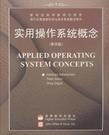实用操作系统概念
出版时间:2001-5 出版社:高等教育出版社 作者:西尔伯沙茨 页数:840 字数:1209000
Tag标签:无
前言
20世纪末,以计算机和通信技术为代表的信息科学和技术,对世界的经济、军事、科技、教育、文化、卫生等方面的发展产生了深刻的影响,由此而兴起的信息产业已经成为世界经济发展的支柱。进入2l世纪,各国为了加快本国的信息产业,加大了资金投入和政策扶持。为了加快我国信息产业的进程,在我国《国民经济和社会发展第十个五年计划纲要》中,明确提出“以信息化带动工业化,发挥后发优势,实现社会生产力的跨越式发展。”信息产业的国际竞争将日趋激烈。在我国加入WT0后,我国信息产业将面临国外竞争对手的严峻挑战。竞争成败最终将取决于信息科学和技术人才的多少与优劣。在20世纪末,我国信息产业虽然得到迅猛发展,但与国际先进国家相比,差距还很大。为了赶上并超过国际先进水平,我国必须加快信息技术人才的培养,特别要培养一大批具有国际竞争能力的高水平的信息技术人才,促进我国信息产业和国家信息化水平的全面提高。为此,教育部高等教育司根据教育部吕福源副部长的意见,在长期重视推动高等学校信息科学和技术的教学的基础上,将实施超前发展战略,采取一些重要举措,加快推动高等学校的信息科学和技术等相关专业的教学工作。在大力宣传、推荐我国专家编著的面向21世纪和“九五”重点的信息科学和技术课程教材的基础上,在有条件的高等学校的某些信息科学和技术课程中推动使用国外优秀教材的影印版进行英语或双语教学,以缩短我国在计算机教学上与国际先进水平的差距,同时也有助于强化我国大学生的英语水平。为了达到上述目的,在分析一些出版社已影印相关教材,一些学校已试用影印教材进行教学的基础上,教育部高等教育司组织并委托高等教育出版社开展国外优秀信息科学和技术优秀教材及其教学辅助材料的弓!进研究与影印出版的试点工作。为推动用影印版教材进行教学创造条件。
内容概要
操作系统是计算机系统中极其重要的部分,也是计算机科学教育的基础课程。本书是在《操作系统概念》(第五版)的基础上编写而成,与该书风格不同,本书通过使用Java实例和众多当代操作系统(如Solaris 2和Windows NT)的实例来阐述操作系统的基本概念。 本书讨论了适用于大多数操作系统的概念,并采用Java语言进行描述。全书内容共分7部分:第一部分,总论(第1~3章),主要介绍了操作系统的概念、作用、设计及构造,这些描述是基于史实的、说明性的,有基础的读者可以略读。第二部分,进程管理(第4~8章),主要介绍了进程调度、进程间通信、进程同步及死锁处理的多种方法,同时对线程进行了讨论。第三部分,内存和存储器管理(第9~13章),主要介绍了内存管理、虚拟内存、文件系统、I/O系统和海量存储器结构。第四部分,分布式系统(第14~17章)。第五部分,保护及安全(第18~19章)。第六部分,案例研究(第20~22章),主要对UNIX Berkley 4.3BSD、Linux、与Microsoft NT等3个案例进行了详细介绍。第七部分,Java入门(附录)。全书各章均附有适量习题。 本书可作为本科高年级学生操作系统课程的入门教材,也可供一年级研究生使用。 内容:1. 序言 2. 计算机系统结构 3. 操作系统结构 4. 进程 5. 线程 6. CPU调度 7. 进程同步 8. 死锁 9. 存储管理10. 虚拟内存 11. 文件系统 12. 输入/输出系统 13. 海量存储器结构 14. 网络结构 15. 分布式通信 16. 分布式协调 17. 分布式文件系统 18. 保护 19. 安全 20. UNIX系统 21. Linux系统 22. Windows NT 附录A Java入门
作者简介
Abraham Bilberschatz is director of the Information Sciences Research center at Bell Laboratories in Murray Hill,New jersey.he Previously held a chaired professorship in the Departments of Compurter Science at the University of Texas at Austin.His re
书籍目录
PART ONE OVERVIEW Chapter1 Introduction Chapter2 Computer-System Structures Chapter3 Operating-System StructuresPART TWO PROCESS MANAGEMENT Chapter4 Processes Chapter5 Threads Chapter6 CPU Scheduling Chapter7 Process Synchronization Chapter8 DeadlocksPART THREE STORAGE MANAGEMENT Chapter9 Memory Management Chapter10 Virtual Memory Chapter11 File Systems Chapter12 I/O Systems Chapter13 Mass-Storage StructurePART FOUR DISTRIBUTED SYSTEMS Chapter14 Network Structures Chapter15 Distributed Communication Chapter16 Distributed Coordination Chapter17 Distributed File SystemsPART FIVE PROTECTION AND SECURITY Chapter18 Protection Chapter19 SecurityPART SIX CASE STUDIES Chapter20 The UNIX System Chapter21 The Linux System Chapter22 Windows NTAppendix A Java PrimerBibliographyCreditsIndex
章节摘录
插图:Symmetric multiprocessing(SMP)means that all processors are peers;thereis no master-slave relationship between processors.Each processor concur-rently runs a copy of the operating system.Figure 1.5 illustrates a typical SMParchitecture.An example of the SMP system is Encore's version of UNIX forthe Multimax computer.This computer can be configured such that it employsdozens of processors.all runnhag copies of UNIX.The benefit of this model isthat many processes can run simultaneouslyn(N processes Can run if there areN CPUs)-without causing a significant deterioration of performance.How.ever, we must carefully control I/O to ensure that the data reach the appropriateprocessor.Also.since the CPUs are separate. one may be sitting idle while another is overloaded. resulting in inefficiencies. These inefficiencies can be avoided if the processors share certain data structures. A multiprocessor system of this florin will allow processes and resources-such as memory-to be shared dynamically among the various processors, and can lower the variance among the processors. Such a system must be written careful as we shall seeing Chapter 7。Virtually all modem operating systems including Windows NT,Solaris,Digital UNIX.OS/2.and Linux-now provide support for SMPThe difference between symmetric and asymmetric multiprocessing may bathe result of either hardware or software. Special hardware call differentiate the multiple processors, or the software can be written to allow only one master and multiple slaves. For instance, Sun's operating system SunOS Version 4 provides asymmetric multiprocessing, whereas Version 5(Solaris 2)is symmetric on the same hardware.As microprocessors become less expensive and more powerful additional operating-system hmctiOIlS are off-loaded to slave processors. or back-ends. For example, it is fairly easy to add a microprocessor with its own memory to manage a disk system. The microprocessor could receive a sequence of requests from the main CPU and implement its own disk queue and schedulingalgorithm.This arrangement relieves the main CPU of the overhead of diskscheduling.PCs contain a microprocessor in the keyboard to convert the keystrokes into codes to be sent to the CPU.In fact, this use of microprocessors has become SO common that it is no longer considered multiprocessing.
媒体关注与评论
书评Applied Operating System Concepts is the first book to provide a precise introduction to the principles of operating systems with numerous contemporary code examples, exercises, and programming projects. Written by the leading authors in the field of operating systems, this book capitalizes on the power of Java(TM) technology to allow students to work with executable code for examples of core concepts. Features of Applied Operating System Concepts * Presents real code examples using the Java programming language * Uses Java technology to introduce difficult concepts like processes, process synchronization, and semaphores * Describes the role of threads in modern operating systems and Java, and provides the opportunity to write multithreaded programs * Introduces up-to-date distributed operating system topics (e.g., Java's Remote Method Invocation, CORBA, RPC) in one concise chapter * Includes chapter-long case studies of UNIX, LINUX, and Windows NT(TM) * Provides a Java Primer appendix
编辑推荐
《实用操作系统概念(影印版)》是由高等教育出版社出版的。
图书封面
图书标签Tags
无
评论、评分、阅读与下载
用户评论 (总计1条)
- 书和预想中的差不多,但是卓越的送货速度实在让人心寒。
